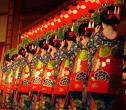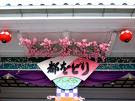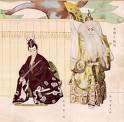[ . BACK to WORLDKIGO TOP . ]
:::::::::::::::::::::::::::::::::::::::::::::::::::::::::::::::::::::::::::::::::::::::::::::::::::
Temple acolytes (chigo 稚児)
***** Location: Japan
***** Season: Non-Seasonal Topic
***** Category: Humanity
*****************************
Explanation
Chigo, small children 稚児
Originally, the word means babies who are still nursing 乳子(ちご).
They are also the children who perform certain duties in a temple, nowadays mostly dancing and taking part in a parade.
In former times also a name for the boys who served in temples and at the mansions of the royalty and lords.
chigo 稚児 catamite
young boys as sexual partners for men
男色の相手にされる少年, GANYMEDE
:::::::::::::::::::::::::::::::::::::::::::::::::::::::::::::::::::::::::::::::::::::::::::::::::::::
procession of children in festive attire,
chigo gyooretsu 稚児行列
 Click HERE to look at more photos !
Click HERE to look at more photos !
:::::::::::::::::::::::::::::::::::::::::::::::::::::::::::::::::::::::::::::::::::::::::::::::::::
Sengen Matsuri 浅間祭 (Asama matsuri)ー photos -
From April 1 to 5. At the Sengen Shrine (Asama jinja) in Shizuoka. To pacify the gods at Mt. Fuji.
Dance of children (chigo mai 稚児舞) is also performed.
 Click HERE for more photos !
. OBSERVANCES – SPRING SAIJIKI .
Click HERE for more photos !
. OBSERVANCES – SPRING SAIJIKI .
:::::::::::::::::::::::::::::::::::::::::::::::::::::::::::::::::::::::::::::::::::::::::::::::::::
Jizo Bosatsu and Chigo
In Japan young children are regarded as "other worldly" and not fully anchored in human life. Fetuses are still referred to as kami no ko or "child of the gods" and also as "Buddha". Before the twentieth century, the probability that a child would survive to age five or seven was often less than 50 percent. Only after that age were they "counted" in a census and could they be "counted upon" to participate in the adult world.
Children were thought of as mysterious beings in a liminal world between the realm of humans and gods. Because of this the gods could speak through them. For centuries prepubescent children in Japan have been chosen as
chigo, or "divine children", who do divination and function as oracles. Even today children below school age still are allowed a somewhat heavenly existence, indulged and protected without many expectations or pressures.
 Jizo Bodhisattva, by Chozen Roshi
Jizo Bodhisattva, by Chozen Roshi
At the age of 13, a child was taken to a special temple and rituals of gratitude were preformed. Now the child was considered an adult.
Temple Visit with a child of 13, juusan-mairi 十三詣
kigo for spring
Juusanbutsu 十三仏 13 Protector Buddhas for the first 13 years of a child
:::::::::::::::::::::::::::::::::::::::::::::::::::::::::::::::::::::::::::::::::::::::::::::::::::
Infant Statues of Buddhist Deities
Chigo Daishi 稚児大師
... more about
Kukai, Kobo Daishi 弘法大師 空海 (Kuukai, Kooboo Daishi)
Chigo Kannon 稚児観音
Chigo Kannon Engi
THE STORY OF KANNON'S MANIFESTATION AS A YOUTH
Chigo Monju 稚児文殊
Chigo Taishi, Shotoku Taishi 稚児太子、聖徳太子
..................Some thoughts by Bernard Faure
... the development of a motif such as that of Guanyin as prostitute, an illustration of this bodhisattva's vow to appear in the world to save beings overcome by desire, must have had a power of arousal that we no longer suspect. The same can be said of figures of goddesses like Benzaiten or Kichijoten,
or of the representations of Manjusri, Shotoku Taishi, and Kobo Daishi as young boys (chigo).
A similar example, in the Christian context, would be the popular image of the Virgin offering her breast to a sick monk. If this male fantasy was triggered by the monastic contemplation of an icon, one might expect the same fantasies to have arisen from Buddhist monks' relations to Guanyin and other similar (male or female) figures.
Read the full article here :
The Buddhist Icon and the Modern Gaze
by Bernard Faure
... ... ...
The homoerotic environment of Buddhist monasteries actually inspired a literary genre,
Chigo monogatari (Tales about acolytes), which took as its theme the love between acolytes (chigo) and their spiritual guides. These homoerotic relationships were ‘firmly grounded in the familiar structures of monastic life’and were meant to appeal to their Buddhist audience.
A common theme of these tales is the transformation of a Buddhist deity, usually Kannon (Sanskrit Avalokite'svara), Jizoo (skt. Ksitigarbha) or Monjushiri (Sanskrit Ma~nju'srii), into a beautiful young acolyte. The acolyte then uses his physical charms to endear himself to an older monk and thereby lead him to Enlightenment.
In the fourteenth-century
Chigo Kannon engi, Kannon takes the form of a beautiful novice to become the lover of a monk who is longing for companionship in his old age. After a few years of close companionship, however, the acolyte dies, leaving the monk desolate. Kannon then appears to the monk, reveals that he and the acolyte were one and the same and delivers a discourse on impermanence.
Read the full article here:
Homosexuality in the Japanese Buddhist Tradition
By By Dharmachari Jnanavira
:::::::::::::::::::::::::::::::::::::::::::::::::::::::::::::::::::::::::::::::::::::::::::::::::::::
A Story from "A Collection of Tales from Uji"
Uji Shui Monogatari . 宇治拾遺物語
13th cent.
是も今は昔、
比叡の山に児ありけり。僧たち、宵のつれづれに、 「いざ、かいもちひせん。」と言ひけるを、この児、心寄せに聞き けり。さりとて、しいださんを待ちて寝ざらんも、わろかりなんと思ひて、片方に寄りて、寝たるよしにて、いで来るを待ちけるに、すでにしいだしたるさまに て、ひしめき合ひたり。
This one happened long ago too.
There was a boy acolyte on Mount Hiei. In the dullness of the evening, this acolyte would hear with pleasure the monks' saying "Hey, let's make some red-bean rice cakes!" So, thinking it would be bad to wait for them to be ready without going to sleep, he went off to a corner to pretend like he was asleep as he waited. Soon it seemed that the cakes were done, and there was a ruckus.
© amidaworld
... ...
Chigo Monogatari
Love Stories or Buddhist Sermons ?
The Divine Boy in Japanese Buddhism : gohoo dooji 護法天童
Carmen Blacker
*****************************
Worldwide use
*****************************
Things found on the way
- - - - - Matsuo Basho 松尾芭蕉
- - - - -
灌仏の日に生れあふ鹿の子かな
Kanbutsu no hi ni umare-au ka no ko kana
happening to be born
on Buddha's birthday
a baby deer!
. Kanbutsu-e 潅仏会 Buddha's Birthday .
.............................................................................
 名月や稚児たち並ぶ堂の縁
名月や稚児たち並ぶ堂の縁
名月や児たち 並ぶ堂の縁
名月や兒たち並ぶ堂の縁
名月や児立ち並ぶ堂の縁
meigetsu ya chigotachi narabu doo no en
名月や児立ち並ぶ堂の縁
meigetsu ya chigo tachinarabu doo no en
harvest moon -
the temple acolytes are lined up
at the veranda
Tr. Gabi Greve
harvest moon -
children lined up
on the temple veranda
Tr. Addiss
harvest moon -
children lined up along
the temple veranda
Tr. Barnhill
Written in 1690 元禄3年8月15日 - at temple Gichuuji 義仲寺 Gichu-Ji.
.............................................................................
月澄むや狐こはがる児の供
tsuki sumu ya kitsune kowagaru chigo no tomo
Written at Keishi's house 畦止 on the topic
"Accompanying a lovely boy in the moonlight"
the moon is clear--
I escort a lovely boy
frightened by a fox
Tr. Ueda
Ueda says, in a note:
"Basho himself, recalling his youth, once wrote: 'There was a time when I was fascinated with the ways of homosexual love.' "
More of Ueda's comment:
source : books.google.co.jp
Ueda's translation of the same haiku
from his 1970 biography of Basho:
How serene the moon!
I escort a handsome youth
Frightened by a fox's howl.
Written in 1694 元禄7年9月28日, Basho age 51.
.............................................................................
 植うる事子のごとくせよ児桜
植うる事子のごとくせよ児桜
uuru koto ko no gotoku seyo chigo-zakura
ūru koto
let us plant them
like handling small children -
mountain cherry trees
Tr. Gabi Greve
Written in the Kanbun time 寛文年間 (1661 -1672)
Most probably on his first trip from Iga Ueno to Edo.
Chigozakura refers to mountain cherry trees with very small blossoms.
He compares the trees to small children.
Chigo-zakura is also a seashell mound in Akita in 寺内村.
. Matsuo Basho - Archives of the WKD .
:::::::::::::::::::::::::::::::::::::::::::::::::::::::::::::::::::::::::::::::::::::::::::::::::::::
 Kobo Daishi as a Boy
Kobo Daishi as a Boy
Temple Nishi Arai Daishi 西新井大師
Daruma Kuyo at Nishi-Arai Daishi Temple
達磨供養
February 3, with bean scattering (mame maki)
"Daruma Kuyo" is a traditional event since 1954 at Nishi-Arai Daishi, an old famous temple, the origin of which dates back to the year of 826. Daruma is a votive symbol for people wishing for the well-being of the family and flourishing business. People bring their Daruma figures once a year on this day to the temple, express gratitude to them, and buy new ones for the next one year. The numbers of old Daruma figures are burnt together in the temple.
The ceremony of "
Daruma Kuyoo" is full of solemnity starting with the entrance of Buddhist monks in the style of mountain priest blowing a conch-shell horn, followed by monks in Buddhism garment, into the garden of the Komyo-den where old Daruma figures are gathered. Then the tens of thousands Daruma figures are lighted in the sounds of sutra reading by the monks. On this same day, the bean-scattering ceremony celebrating the coming of spring is held in the Hon-den. You will also find it enjoyable to stroll along the road to the San-mon where souvenir shops, dango (Japanese sweet dumplings) shops, etc. stands in a row.
(Nishi-Arai Daishi Temple)
*****************************
HAIKU
kanbutsu ya sutego sunawachi tera no chigo
Buddha's birthday;
The deserted child,--
Now a boy of the temple.
Kikaku 基角
(Tr. Blyth)
:::::::::::::::::::::::::::::::::::::::::::::::::::::::::::::::::::::::::::::::::::::::::::::::::::
... ... ...
Issa and Chigo Haiku
寺の児赤かたびらはいつ迄ぞ
tera no chigo aka katabira wa itsu made zo
temple toddler--
how long will you wear
your little red kimono?
寺山や児はころげる蝶はとぶ
tera yama ya chigo wa korogeru chô wa tobu
temple mountain--
a baby tumbles
a butterfly flits
児達や盃をく也蓮の花
chigotachi ya sakazuki oku nari hasu no hana
the toddlers
put them in sake cups...
lotus blossoms
© Tr. David Lanoue
Issa haiku about CHIGO
:::::::::::::::::::::::::::::::::::::::::::::::::::::::::::::::::::::::::::::::::::::::::::::::::::::
shii hirou Yokawa no chigo no itoma kana
Picking up acorns,
the temple boy of Yokawa
in his hour of leisure.
--Buson, trans. Shiffert and Sawa
mishi koi no chigo neriide yo dokuyo
That altar boy --
how I wish
he would come out again.
--Buson, trans. unknown
http://www.cs.arizona.edu/~kece/Personal/Poems/buson.html
*****************************
Related words
*****
Buddha's Birthday and the Flower Hall (hana midoo) Japan
*****
Child, Children (kodomo) of all kinds
[ . BACK to DARUMA MUSEUM TOP . ]
[ . BACK to WORLDKIGO . TOP . ]
:::::::::::::::::::::::::::::::::::::::::::::::::::::::::::::::::::::::::::::::::::::::::::::::::::::


















































